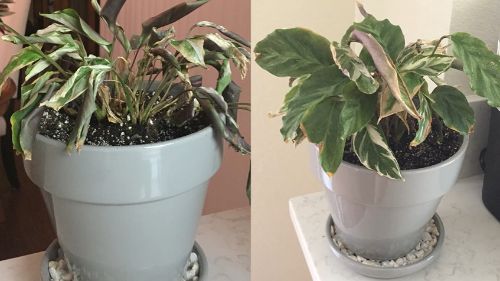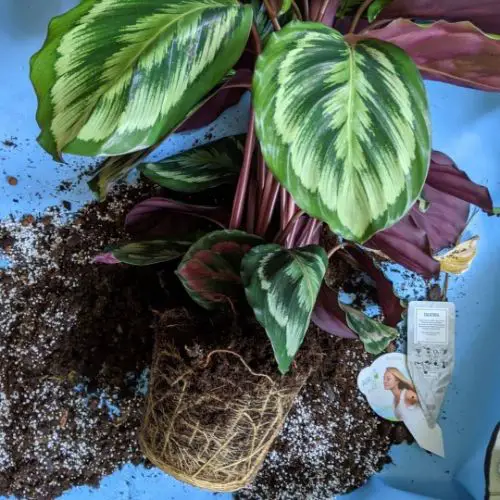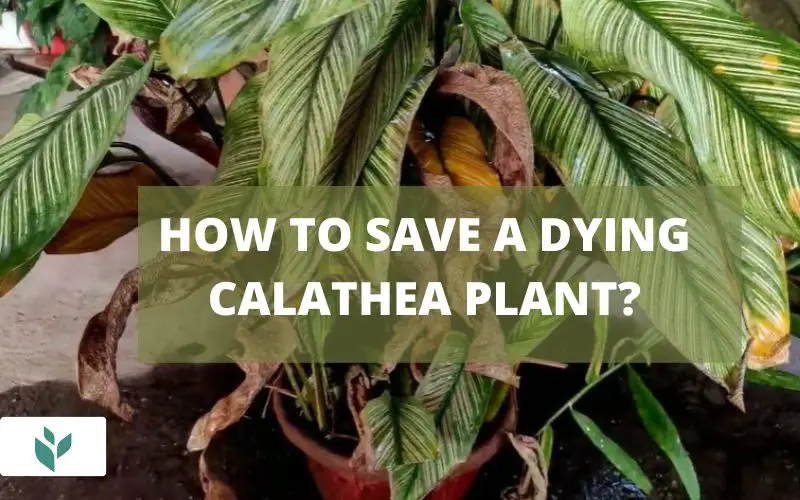It is a heartbreaking sight to see: a once-healthy Calathea plant that is now wilting, the leaves droop and turn brown and crispy. You may be wondering how to save a dying Calathea plant.
Try not to panic, there is still hope! In this blog post, we will discuss simple tips to revive your Calathea tree and the most common reasons why Calathea plants die. So, if your Calathea is looking a bit sickly, read on for some helpful advice!
How to Save a Dying Calathea Plant?
It is no surprise that Calathea plants are popular among plant enthusiasts. With their lush green leaves and elegant stature, they add a touch of beauty to any space. However, even the hardiest of plants can succumb to disease or injury, and this appears to be the case with one Calathea plant you are caring for. Despite my best efforts, it seems to be dying a slow death. Here are the actions you need to take to save it.
Change the location of the plant
Your Calathea’s close surroundings could be the source of its ill health. There is a significant likelihood that it is receiving excessive sunlight and heat if it is directly adjacent to a southern or western window. Calathea plants need bright, indirect sunlight.
Long-term exposure to direct sunlight causes the leaves to become dehydrated, turning them into pale, dried-out husks of what they once were.
Another factor that might shock a Calathea’s system and make its leaves drop and wither away is a cold draft. Thus, windowsills can be hazardous even on dismal winter days when sunlight is not an issue.
Even if sunlight and temperature shock aren’t the main reason for Calathea’s poor health, they can make other problems worse. So it’s advisable to relocate them right away till the issue has been found and resolved. Move it 4-5 feet away from any adjacent windows instead of keeping it in a pitch-black room. Use a plant shading cloth if the area is outdoors to give filtered light.

Check the temperature
You can identify the source of your plant’s suffering. Any temperature outside of Calathea’s preferred range will injure it; extreme heat has a similar effect to sun scorch, while extreme cold frequently causes leaves and stems to turn yellow and white or red blotches around the veins.65 to 80 degrees Fahrenheit is the ideal range for Calathea’s health.
Make sure your plant isn’t placed next to a heater or air conditioner that might be exposing it to sporadic bursts of heat or cold. Move it to a warm location if the temperature falls below 60 °F. Your plant would be healthy following many hours of exposure to warmer temps.
Prune away dying leaves regularly
Your Calathea won’t benefit from leaves that are fully brown, dry, and shriveled. Cut them off to encourage new growth in your Calathea.
In order to preserve as much healthy tissue as possible, cut the leaves off as high on the stem as you can. If a leaf is only partially dead, only remove the shriveled areas and leave the green parts of the leaf intact. They’ll keep consuming energy to support your Calathea’s recovery.

Suffering from pests
Take us the opportunity while pruning your plant to look for spider mites and insect indications like aphids or mealybugs. It’s critical to eradicate these pests as soon as possible because they might rob your plant of its life.
Although not all Calathea pests are plainly visible to the human eye, some are. Tiny ovoid bumps on the leaves and stems and small tufts of white fuzz are indicators that a bug has attacked a plant or Sticky substance, etc.
Webs on the leaves and stems at the same time show that spider mites are draining the sap from the leaves, are capable of reaching the plant cell, and are the cause of plants dying.
Solution:
- Neem oil and warm water work well to control spider mites
- Immediately quarantine the plant and keep it away from any other indoor plants
- Use a cloth that has been dipped in the same solution to wipe the leaves and stems
- Continue doing this for a few days to make sure the infestation is gone
- To keep the pests from becoming resistant, you might need to occasionally change your remedies. If the insect infestation is severe, try to apply appropriate pesticides to control it
Check the Roots and repot

If your Calathea’s disease is not being caused by pests or a visible environmental factor, then you most likely have a root and soil problem.
In addition to harming plants’ overall health and causing root rot, too moist soil serves as a haven for germs and fungi. If your Calathea begins to wilt, curl its leaves, or turns dark or brown at the tip of the leaves, it is generally not in good health. In the future, if this condition persists, plants begin to die.
There is no assurance that you weren’t overwatering, even if the soil currently appears to be dry. The mixture at the bottom of the pot can stay wet a lot longer than the layers on top. Additionally, even after the soil has dried out, your Calathea may still be infected with root rot if it has been exposed to it.
You need to take the plant out of the pot.
Examine the roots carefully and remove any soil that is still adhering to them.
if the plant has root rot, therefore you should prune or repot any of them that feel squishy, or appear gray or black.
Any rotten roots can be cut out, beginning with the ones at the bottom. Remember to sanitize the scissors’ blades between cuts by wiping them down with a disinfectant.
You can treat root rot by repotting your Calathea plant after removing the rotten roots that have started to harm it.
You may also like: When to repot Calathea: The best time for your plant
Check your plant’s watering schedule
The main reasons why Calathea plants die are either underwatering or overwatering.
Proper moisture content is necessary for a healthy plant. This entails providing the soil and environment with adequate moisture for Calatheas.
Wilted leaves and fungus can develop in both wet and dry soil. Ensure that your Calathea is growing in damp soil that and that it has time to dry out a little between waterings.
Water Calathea once the top 2.4 cm has dried out. If you are watering your plant more than once a week, cut back to once every ten days or so. Before watering once more, let the top inch of soil dry off. A plant can be killed by too much water.
Avoid using tap water to water your Calathea instead; only use pure or distilled water.
Make sure your Calathea has a sufficient drainage hole and soil that drains adequately if it is growing in a container. Water will pool as a result of poor drainage. This will ultimately result in root rot.
Fertilize the plants
A lack of nutrients can also cause Calathea plants to die, so make sure to use a high-quality fertilizer specifically for tropical plants. Fertilize regularly. Use a balanced fertilizer every two weeks during the growing season to keep your Calathea healthy and happy.
Fertilizer burns. If you use too much fertilizer, it can “burn” your plant’s roots and cause the leaves to turn brown and brittle.
How to save a dying Calathea plant to help Calathea survive
How to Ensure the Calathea Plant Grows Healthily
Here are tips that will help you to ensure that your plant grows healthily.
- Make sure that you’re watering it regularly. Calathea plants like their soil to be moist, but not waterlogged. Therefore, it’s important to check the soil before watering to ensure that it is dry.
- Make sure the pot has drainage holes to allow excess water to escape.
- Mist the leaves with water every few days to raise the humidity level around the plant.
- Give your plant plenty of bright, indirect light. Calatheas thrive in well-lit rooms but can’t tolerate direct sunlight.
- Keep an eye out for pests such as mites, aphids, and mealybugs. These pests can quickly damage a Calathea plant. If you spot any pests, isolate the affected plant and treat it with an appropriate pesticide.
- Don’t forget to fertilize your Calathea regularly. A good quality fertilizer will provide the nutrients that your plant needs to grow healthily.
- Monitor the progress and adjust your care as needed.
By following these simple tips, you can keep your Calathea plant happy and healthy for many years to come.
Conclusion
By following the tips in this blog post, you should be able to revive your dying Calathea plant and keep it healthy for years to come! Just remember to provide indirect sunlight, water deeply but less often, and fertilize regularly. extra humidity. With a bit of care, your Calathea will thrive!
Do you have any tips for how to save a dying Calathea plant? Share them in the comments below!
If you found this blog post helpful, be sure to share it with your friends and family who are also planting lovers! And don’t forget to check out our other blog posts for more gardening tips and tricks.


